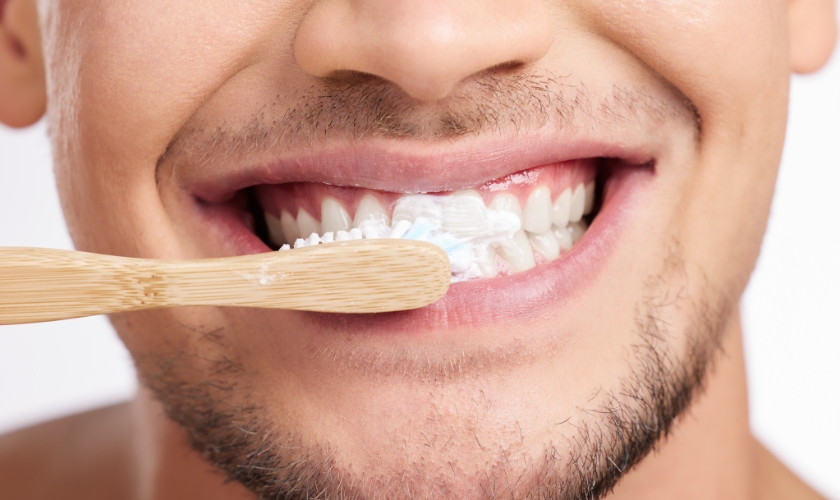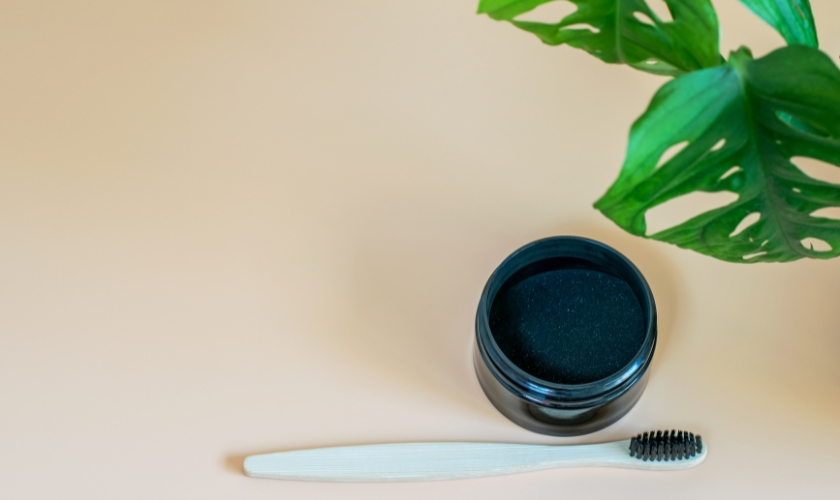
7 Easy Natural Remedies for Whiter Teeth at Home
Your confidence and looks can both be enhanced by a brilliant smile. In addition to being successful, professional teeth whitening procedures can also be expensive. Fortunately, several natural methods can help you achieve a whiter smile right from the comfort of your home.
This blog explores seven natural teeth whitening techniques things you can simply include into your everyday schedule.
1. Baking Soda and Hydrogen Peroxide
Baking soda and hydrogen peroxide are well-known for their ability to brighten teeth. Baking soda’s mild abrasive qualities help remove surface stains, and hydrogen peroxide works as a gentle bleach to whiten teeth.
How to Use:
- One spoonful of baking soda should be combined with 1 teaspoon of hydrogen peroxide.
- Using your toothbrush, apply the paste and gently brush your teeth.
- Leave it on for 1-2 minutes, then rinse thoroughly with water.
Benefits:
- Helps remove surface stains and whiten teeth.
- Hydrogen peroxide has antibacterial properties that aid in oral health.
Note: Limit use to 1-2 times per week to avoid enamel damage.
2. Coconut Oil Pulling
Swishing oil around your mouth to whiten teeth and promote oral health is known as “coconut oil pulling,” and it dates back thousands of years. This method helps to reduce plaque and bacteria, which can contribute to discoloration.
How to Use:
- One spoonful of coconut oil should be swished around your mouth for 10-15 minutes.
- To keep your sink from being clogged, spit the oil into a garbage container.
- Use your regular toothbrush to clean your teeth after using mouthwash.
Benefits:
- Reduces plaque buildup and bacteria.
- It can help to naturally whiten teeth over time.
Note: For best results, use coconut oil pulling daily or a few times a week.
3. Apple Cider Vinegar
Apple cider vinegar (ACV) has natural bleaching properties due to its acidic nature. It aids in the removal of stains and can be a useful addition to your whitening routine.
How to Use:
- Dilute 1-2 tablespoons of ACV in a cup of water.
- For one to two minutes, swish the mixture around your mouth.
- Rinse well with water, then give your teeth a brush.
Benefits:
- Helps remove stains and freshen breath.
- ACV’s acidity can aid in whitening teeth.
Note: Use this method sparingly to prevent enamel erosion. Once a week is sufficient.
4. Strawberries and Baking Soda
Malic acid, which is present in strawberries, aids in the removal of surface stains. They make a natural whitening paste that can improve your smile when mixed with baking soda.
How to Use:
- Mash a few fresh strawberries and mix them with 1/2 teaspoon of baking soda.
- Apply the mixture to your teeth and let it sit for 5 minutes.
- Rinse with water and brush your teeth.
Benefits:
- Provides a natural, fruity option for teeth whitening.
- The combination of malic acid and baking soda helps to whiten teeth.
Note: Use this method once a week to avoid excessive acid exposure.
5. Activated Charcoal
One extremely absorbent material that can help get rid of toxins and stains from your teeth is activated charcoal. It works by binding to particles that cause discoloration and removing them.
How to Use:
- After soaking your toothbrush, dip it into the powdered activated charcoal.
- Gently brush your teeth for 2-3 minutes.
- Rinse your mouth well with water to get rid of any remaining charcoal.
Benefits:
- Helps to remove surface stains and toxins.
- It can enhance the way your teeth look overall.
Note: Use activated charcoal once or twice a week to prevent potential enamel wear.
6. Baking Soda and Lemon Juice
Combining baking soda with lemon juice can create a potent natural whitening agent. While baking soda works well to remove stains, lemon juice provides a natural bleaching effect.
How to Use:
- Mix one teaspoon of baking soda with a few drops of lemon juice to create a paste.
- Apply the paste to your teeth with a toothbrush.
- After letting it sit for one to two minutes, rinse with water.
Benefits:
- Effectively removes surface stains.
- Lemon juice offers a natural whitening boost.
Note: Use this method cautiously and no more than once a week to avoid enamel damage.
7. Good Oral Hygiene Practices
You can’t have healthy, white teeth unless you practice good oral hygiene. Frequent brushing and flossing lowers the chance of stains and helps stop plaque accumulation.
Tips:
- Use fluoride toothpaste and brush your teeth twice a day.
- Floss daily to get rid of plaque and food residue.
- Limit or stay away from foods and beverages that stain, such as tea and coffee.
Benefits:
- Prevents new stains from forming.
- Maintains overall dental health and hygiene.
Note: Combine good oral hygiene with natural whitening methods for the best results.
Achieving a whiter smile doesn’t have to involve costly treatments or harsh chemicals. By incorporating these natural teeth whitening methods into your routine, you can enjoy a more radiant, confident grin from the comfort of your own home. Remember to use these techniques in moderation and maintain good oral hygiene to keep your teeth looking their best. With consistent care and these natural remedies, you’ll be well on your way to a sparkling, white smile.
Frequently Asked Questions
The time it takes to see noticeable results from natural teeth whitening can vary based on the method used and the individual’s dental condition. Generally, you may start to see improvements within 1-2 weeks of consistent use. For methods like baking soda and lemon juice, results can be quicker, while other methods like oil pulling might take a bit longer to show effects. Consistency is key, so stick with the method that suits you best.
Teeth whitening can be accomplished with hydrogen peroxide, but it should be diluted to avoid irritation. Use a solution that is no stronger than 3 percent hydrogen peroxide combined with the same volume of water. Direct application of undiluted hydrogen peroxide can cause gum irritation and enamel damage. Always rinse thoroughly after use and consult your dentist if you experience any discomfort.
Natural teeth whitening methods typically affect natural tooth enamel and may not change the color of dental restorations such as crowns, fillings, or veneers. These materials do not bleach the same way natural teeth do. If you have restorations and want to brighten your smile, it’s best to consult with your dentist about options that can address both natural teeth and restorations.




